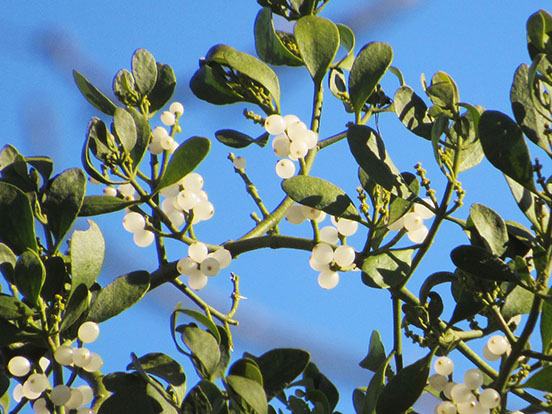“Helping You Find Plants That Work”
Behind Mistletoe
Everything You Did and Didn’t Need to Know About This Christmas Plant
In Greek, Roman, and Celtic Druid history, mistletoe acted as a panacea- to cure poisons, illness, pain, and more. The most common folklore traced to this tradition comes from Norse Mythology. Baldur (Odin’s son) was condemned by a prophecy to die. Not wanting any harm to come to her son, Frigg ventured about the entire Earth, ensuring all plants and animals agreed to keep her son safe. As with most stories- she forgot one plant. Obsessed with love and beauty, Frigg neglected mistletoe- as it was bland and undesirable. Loki used this oversight and fashioned the plant into a lethal arrow to defeat Baldur, and he did. However, the Gods resurrected Baldur, and Frigg, elated that her son had come back from the dead, declared that she would kiss anyone who passed under the mistletoe and made the plant a symbol of love- not to be forgotten lest it force anyone into bad luck, akin to how she ignored the plant (later interpreted to be that of vitality and fertility).
This evergreen plant seems like a low-maintenance project. After all, you primarily need to take care of the host tree it is attached to and provide full sun to part shade conditions. Like a telemarketer, it is parasitic and will only grow and obtain nutrients and water from the host tree. Keep mistletoe roots and vines in check to prevent further takeover of other trees. The largest it should grow is 3 feet by 3 feet. Some host trees that mistletoe prefers (and that you can sacrifice) include maple, poplar, aspen, walnut, elm, and oak. While it is commonly used in tradition, it is quite toxic to all organisms, so make sure no one puts it in their salad! It also produces alluring-looking berries, but don’t be tempted! Also, please try to grow it inside (especially the dwarf variety), as it is very invasive. Trash after use (don’t compost!). Finally, since it is such an invasive plant, bugs leave the plant alone!
Some species that you can look for (that won’t be as damaging) include American mistletoe, European mistletoe, and Big Leaf mistletoe. To propagate, you will need mistletoe berries (will be white), gloves, and a host tree. Smash the berries, and press into the bark a little higher than the base of the tree. That’s it! However, it will take a year for the seeds to take. If you want to get rid of some unwanted growth, there are two options you can employ. Begin by cutting away the growth you don’t want. Then apply black plastic on the infested area or use herbicides.
If you (understandably) don’t want anything to do with mistletoe anymore, may this article serve as a basis to know what to look for if you see your trees suffering from an unknown parasite. So enjoy a moment of romance with the knowledge that you didn’t cause your son’s downfall because you ignored this plant.

A ball of mistletoe complete with berries!
*Credit to Gemma Johnstone from The Spruce, Even Andrews of HISTORY, and Rob Dunn of Smithsonian Magazine.

